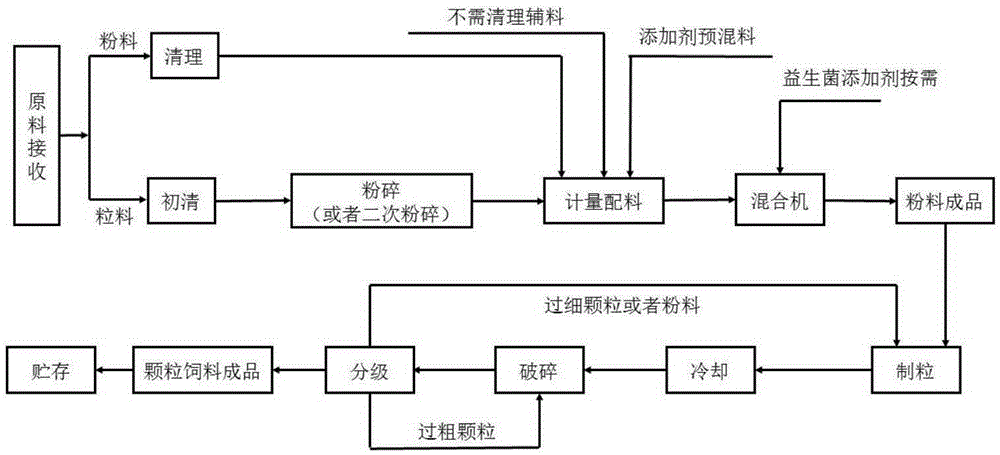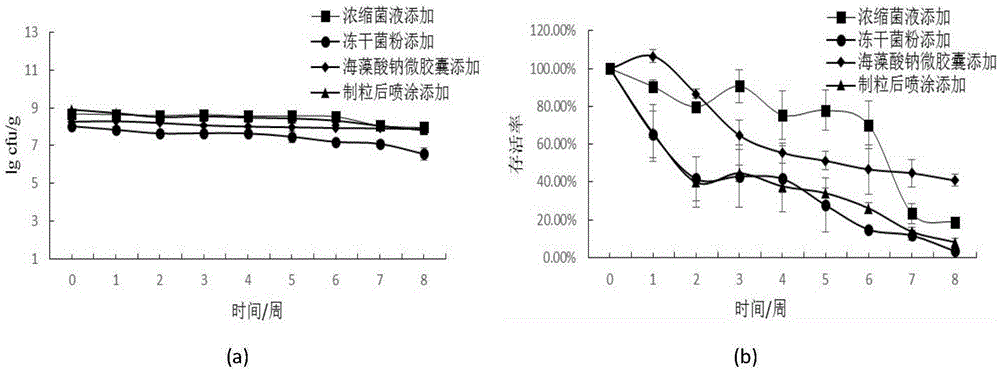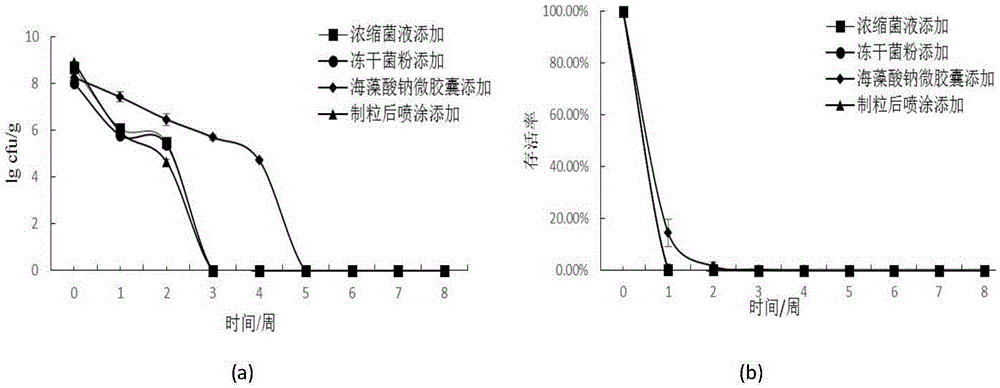Plant lactobacillus feed capable of relieving tilapia lead toxicity
A technology of Lactobacillus plantarum and tilapia, applied in the field of feed, can solve the problems of alleviating lead poisoning of aquatic organisms, which have not been reported by anyone, and achieve the effect of alleviating oxidative stress damage, accelerating growth rate, and improving the activity of intestinal digestive enzymes
- Summary
- Abstract
- Description
- Claims
- Application Information
AI Technical Summary
Problems solved by technology
Method used
Image
Examples
Embodiment 1
[0050] Example 1 Effect of mixing on the activity of feed CGMCC NO.5494 in different ways of adding probiotics
[0051] The concentrated bacterial liquid, freeze-dried bacterial powder, and sodium alginate microcapsule bacterial agent produced by CGMCCNO.5494 were added to the basic feed of tilapia, and mixed into powdered feed by a mixer, and the powdered feed was counted by colony plate counting method. The content of live bacteria in the feed is detected, and the obtained result is multiplied by the weight of the feed, which is recorded as M; the colony plate count is carried out on the concentrated bacterial liquid, freeze-dried bacterial powder and sodium alginate microcapsule bacterial agent before adding to the feed, and the total number of live bacteria is calculated. , recorded as M0, the survival rate=M / M0×100% was obtained. The results are shown in Table 3:
[0052] Table 3 Effect of mixing on the survival rate of feed CGMCCNO.5494 with different probiotic addition...
Embodiment 2
[0056] Example 2 Effect of granulation on the activity of feed CGMCC NO.5494 in different ways of adding probiotics
[0057] The concentrated bacterial liquid, freeze-dried bacterial powder, and sodium alginate microcapsule bacterial agent produced by CGMCCNO.5494 were added to the basic feed of tilapia, and mixed into powdered feed by a mixer. Colony plate counting was used for detection; the mixed powder feed was granulated in a granulator at a granulation temperature of 70°C, and the live bacteria content in the pelleted feed was detected by colony plate counting after granulation. The results are shown in Table 4:
[0058] Table 4 Effect of granulation on the survival rate of feed CGMCC5494 with different probiotic addition methods
[0059]
[0060] Note: Different letters represent significant differences between groups (P<0.05)
[0061] The granulation unit operation had a great influence on the activity of CGMCCNO.5494 with different addition methods. The method o...
Embodiment 3
[0062] Example 3 Effect of storage on the activity of feed CGMCCNO.5494 in different ways of adding probiotics
[0063] The granulated feed processed with concentrated bacterial liquid, freeze-dried bacterial powder, sodium alginate microcapsules and sprayed after granulation was stored at 4°C and 25°C for two months, and the pelleted feed was plated once every other week. Count the number of live bacteria and calculate their survival rate.
[0064] The experimental results are attached figure 2 , attached image 3 shown, by attaching figure 2 It can be seen that under the condition of 4°C, the activity of CGMCCNO.5494 in each group showed good stability, as shown in the attached figure 2 As shown in (a), within one month, the activities of CGMCC NO.5494 in the four groups can all be maintained at the same order of magnitude. In the 2-month storage experiment, the sodium alginate microcapsule group showed the best stability, and the number of viable bacteria could still...
PUM
 Login to View More
Login to View More Abstract
Description
Claims
Application Information
 Login to View More
Login to View More - R&D
- Intellectual Property
- Life Sciences
- Materials
- Tech Scout
- Unparalleled Data Quality
- Higher Quality Content
- 60% Fewer Hallucinations
Browse by: Latest US Patents, China's latest patents, Technical Efficacy Thesaurus, Application Domain, Technology Topic, Popular Technical Reports.
© 2025 PatSnap. All rights reserved.Legal|Privacy policy|Modern Slavery Act Transparency Statement|Sitemap|About US| Contact US: help@patsnap.com



